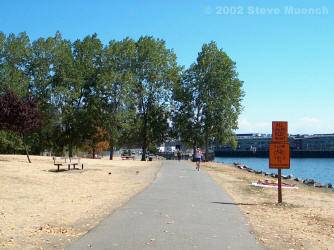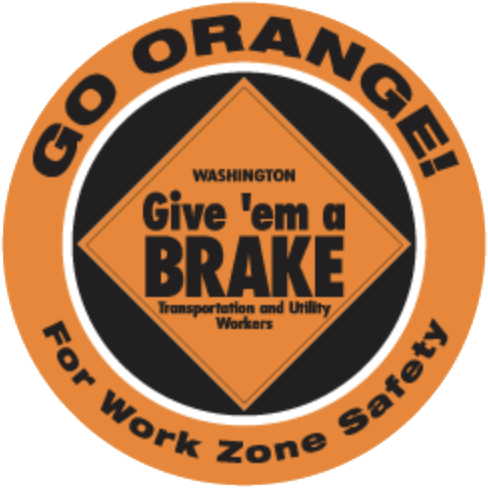Pathways
Bicycle, walking and golf cart paths are specifically intended for bicycles, golf carts, pedestrians and other non-vehicular traffic. They are generally thinner than vehicular pavement and usually have a very smooth surface.

Figure 2: Smaller Parking Lot

Figure 2: Myrtle Edwards Park in Seattle
Assumed Traffic
Bicycles, golf carts, pedestrians, rollerbladers, skateboarders, etc. The pavement is not intended to withstand repeated vehicle loading but the occasional maintenance light truck can be accommodated without undue damage.
Design Considerations
- Bicyclists, pedestrians and rollerbladers tend to like an extremely smooth pavement. Nominal maximum aggregate sizes (NMAS) larger than about 0.5 inches are noticeably rougher to rollerbladers and skateboarders. Consider the use of a 3/8 inch NMAS hot mix for a fine textured pavement surface.
- Path widths less than 8 ft. require smaller equipment and more labor to pave. The narrowest commonly available paver uses an 8 ft. wide screed. Paving widths less than 8 ft. require specialized equipment and standard dump trucks will not be able to access the site, which can result in more labor, resulting in a higher cost per ton of HMA placed. If there is room, an 8 ft. wide path can be constructed at a lower cost per square yard than a 5 ft. wide path in the same location.
- Design paths with a minimum slope of 2 percent (0.25 inches per foot). Slopes less than this are difficult to construct and may not prevent pooling of water during wet weather.
Construction Considerations
- Because a smooth pavement is essential for user satisfaction and safety, special care should be taken to ensure roots from nearby trees are not growing directly below the intended path location. If left in place, these roots may cause local pavement upheavals, which can be a safety hazard.
- Areas that show a pronounced deflection under heavy construction traffic indicate instability in the subgrade. Such areas probably require removal of the material and replacement with suitable subgrade soil material such as crushed stone or gravel borrow.
- Where there is the possibility of recurrent damaging vegetation growth, a quality commercial grade herbicide should be used prior to paving and as a preventative maintenance action along the pavement shoulders. Large area application of herbicides should be performed by an experienced, licensed professional.
Recommended References
- American Association of State Highway and Transportation Officials (AASHTO). (1999). Guideline for the Development of Bicycle Facilities, 3rd edition. AASHTO. Washington, D.C. (www.aashto.org)
- Federal Highway Administration (FHWA). Bicycle and Pedestrian Program Web Page. Provides a detailed list of available bicycle and pedestrian publications and design guidance. (http://www.fhwa.dot.gov/environment/bicycle_pedestrian)
- Pedestrian and Bicycle Information Center. A clearinghouse for information about health and safety, engineering, advocacy, education, enforcement and access and mobility. (www.pedbikeinfo.org)
- Bicycling in Washington (www.wsdot.wa.gov/bike/)
- Asphalt Institute. Model Specifications for Small Paving Jobs. CL-2. Asphalt Institute. Lexington, KY. (http://www.asphaltinstitute.org/wp-content/uploads/Thickness_Mix/CL-2%20Model%20Specifications%20For%20Small%20Paving%20Jobs.pdf)
Design Catalog



